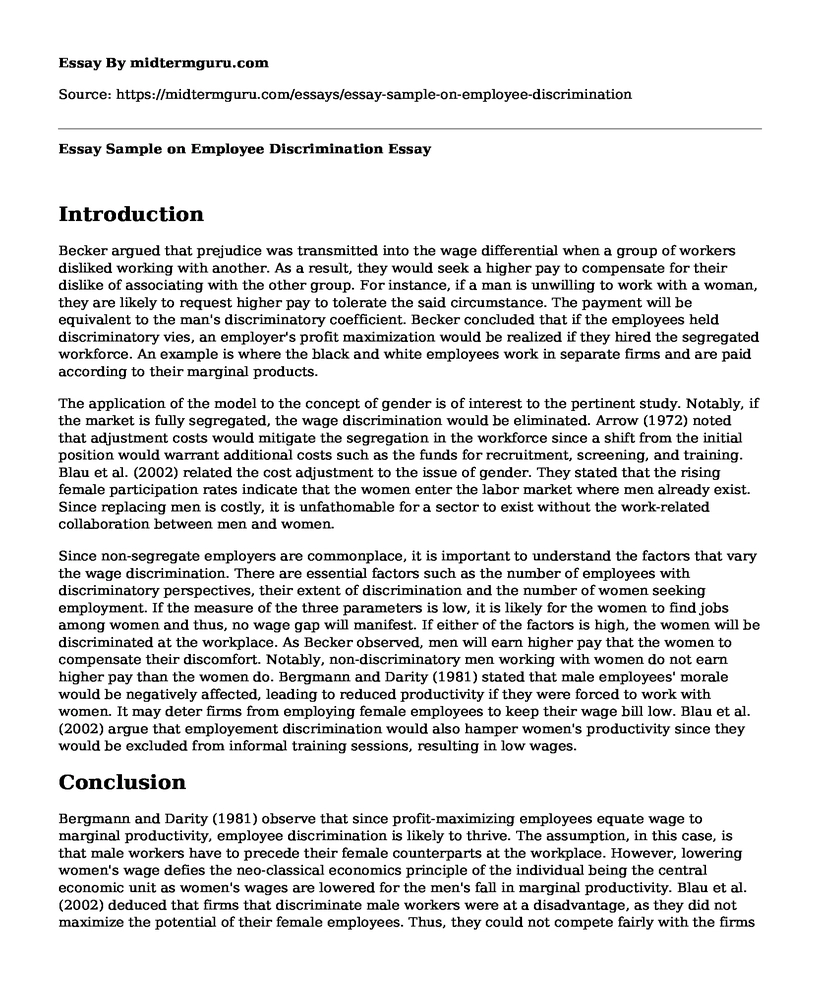Introduction
Becker argued that prejudice was transmitted into the wage differential when a group of workers disliked working with another. As a result, they would seek a higher pay to compensate for their dislike of associating with the other group. For instance, if a man is unwilling to work with a woman, they are likely to request higher pay to tolerate the said circumstance. The payment will be equivalent to the man's discriminatory coefficient. Becker concluded that if the employees held discriminatory vies, an employer's profit maximization would be realized if they hired the segregated workforce. An example is where the black and white employees work in separate firms and are paid according to their marginal products.
The application of the model to the concept of gender is of interest to the pertinent study. Notably, if the market is fully segregated, the wage discrimination would be eliminated. Arrow (1972) noted that adjustment costs would mitigate the segregation in the workforce since a shift from the initial position would warrant additional costs such as the funds for recruitment, screening, and training. Blau et al. (2002) related the cost adjustment to the issue of gender. They stated that the rising female participation rates indicate that the women enter the labor market where men already exist. Since replacing men is costly, it is unfathomable for a sector to exist without the work-related collaboration between men and women.
Since non-segregate employers are commonplace, it is important to understand the factors that vary the wage discrimination. There are essential factors such as the number of employees with discriminatory perspectives, their extent of discrimination and the number of women seeking employment. If the measure of the three parameters is low, it is likely for the women to find jobs among women and thus, no wage gap will manifest. If either of the factors is high, the women will be discriminated at the workplace. As Becker observed, men will earn higher pay that the women to compensate their discomfort. Notably, non-discriminatory men working with women do not earn higher pay than the women do. Bergmann and Darity (1981) stated that male employees' morale would be negatively affected, leading to reduced productivity if they were forced to work with women. It may deter firms from employing female employees to keep their wage bill low. Blau et al. (2002) argue that employement discrimination would also hamper women's productivity since they would be excluded from informal training sessions, resulting in low wages.
Conclusion
Bergmann and Darity (1981) observe that since profit-maximizing employees equate wage to marginal productivity, employee discrimination is likely to thrive. The assumption, in this case, is that male workers have to precede their female counterparts at the workplace. However, lowering women's wage defies the neo-classical economics principle of the individual being the central economic unit as women's wages are lowered for the men's fall in marginal productivity. Blau et al. (2002) deduced that firms that discriminate male workers were at a disadvantage, as they did not maximize the potential of their female employees. Thus, they could not compete fairly with the firms with non-discriminating men.
Cite this page
Essay Sample on Employee Discrimination. (2022, Oct 04). Retrieved from https://midtermguru.com/essays/essay-sample-on-employee-discrimination
If you are the original author of this essay and no longer wish to have it published on the midtermguru.com website, please click below to request its removal:
- Essay on Substance Abuse Prevalence and Patterns
- Essay Sample on Performance Improvement and Professional Education
- Essay Sample on Use of Drug Enhancement in the Major Baseball League in the Late 1990S to Late 2000
- Essay Sample on Female Body Image Over the Decades
- Research Paper on Intimate Relationship Violence
- Work-Life Balance: A Necessity in the Business World - Essay Sample
- Eliminating Poverty: Unlocking Social Issues Through Charities & Philanthropy - Essay Sample







